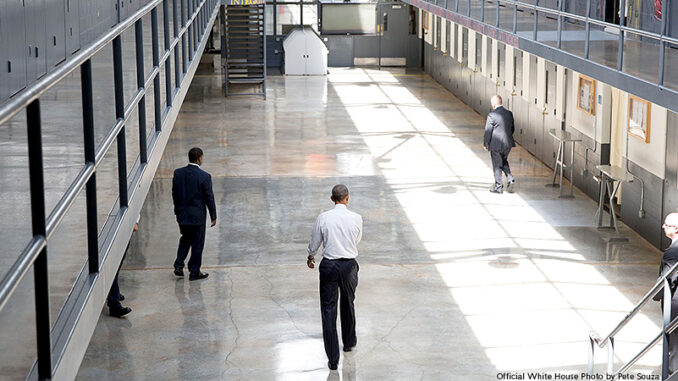
Last month, President Obama made a visit to the El Reno Correctional Institution in El Reno, Oklahoma, making him the first sitting American president to visit a federal prison. The trip was an effort to highlight his commitment to overhauling the nation’s criminal justice system. “Mass incarceration makes our entire country worse off,” he said in an address, “and we need to do something about it.” As the president and Congress move toward enacting reform legislation by the end of the year, btw takes a look at how we got here and what can be done to move forward.
Sentencing Laws
There are two pieces of major legislation that are considered largely responsible for the steep rise in those sentenced to federal prison. Under President Ronald Reagan, Congress passed the Anti-Drug Abuse Act of 1986 as part of the government’s “War on Drugs” initiative. This included mandatory minimums for certain offenses, which meant that judges were forced to abide by pre-determined prison terms instead of considering the details of each case.
In 1994, Congress passed the Violent Crime Control and Law Enforcement Act. It was the largest crime bill in history, providing $9.7 billion in funding to build new prisons, and create 100,000 jobs for police officers. By the next year, the number of people incarcerated accelerated from 949,000 to 1.5 million. As of 2014, that number had risen to 2.4 million, with nearly 60 percent of inmates serving time for non-violent drug offenses.
Making a Smarter System
President Obama announced his proposal to reform the U.S. criminal justice system during the recent convention of the National Association for the Advancement of Colored People (NAACP). He outlined three areas of focus:
- Community More investment in community programs aimed at young people will ultimately reduce the need to incarcerate them later. The president stressed the need for education, job training and an initiative called “ban the box,” aimed at persuading employers to remove a checkbox asking if applicants have a criminal record.
- Courtroom For nonviolent drug crimes, long-term mandatory minimums should be reduced or eliminated. This will give prosecutors and judges the discretion to choose more appropriate punishments. Alternatives to incarceration, like substance abuse and probation programs, should be considered and supported.
- Cell Block Conditions like overcrowding, gang activity, rape and the overuse of solitary confinement should not be tolerated. Prisons should invest in opportunities like career training and social services on the inside for preparing inmates for release back into society.
Overwhelming Support
On this issue, Democrats and Republicans are in rare agreement over the need to release people from prison who, as House Speaker John Boehner says, “really don’t need to be there.” The majority of the American people reflect this opinion, according to a recent poll conducted by the American Civil Liberties Union (ACLU). It revealed that 69 percent of voters believe it is important to reduce the prison population. In addition, most believe in a shifting focus toward crime prevention, rehabilitation and treatment for addiction and mental illness.
